Have you seen Dr. Marie Claire Haver, author of The New Menopause, on Instagram wearing a weighted vest or listened to Dr. Andy Galpin speak about aging and muscle? It will change your life.
Dr. Mary Claire Haver emphasizes the importance of strength training for women, especially as they age. She advocates for weight-bearing exercises to improve bone density, enhance metabolism, and maintain muscle mass. This is crucial for reducing the risk of osteoporosis and ensuring overall strength and endurance. Strength training also helps in managing weight and improving balance, which is vital for preventing falls and maintaining a high quality of life.
Dr. Galpin believes that muscle quality and quantity significantly impact long-term health outcomes. Losing muscle mass with age, known as sarcopenia, can lead to increased frailty and higher risks of falls and injuries. To combat muscle loss, Dr. Galpin advocates for consistent strength training, proper nutrition, and progressive overload in exercise routines. He stresses that adaptation and improvement in muscle function require continual challenges to the body through increased weights, repetitions, or exercise complexity. Additionally, he underscores the importance of protein intake to support muscle repair and growth, especially as one ages.
I’ve been strength training in one form or another for most of my life. As a child, I was a competitive ice skater, which improved my performance. As a young adult, I trained to look a certain way, and now at 56, I focus on keeping and increasing my muscle mass. Why? Because we can and we should.
Why Women Should Do Weight-Bearing Exercises as They Age
As women age, maintaining muscle mass becomes crucial for several reasons:
- Improved Bone Density: Weight-bearing exercises help strengthen bones, reducing the risk of osteoporosis.
- Enhanced Metabolism: More muscle mass means a higher resting metabolic rate, helping to manage weight more effectively.
- Better Balance and Coordination: Stronger muscles improve stability, reducing the risk of falls.
- Overall Strength and Endurance: Increased muscle mass enhances daily functional activities, improving quality of life.
How Much Protein Do We Really Need?
The general recommendation is 1.6 grams per kilogram of body weight, but Dr. Galpin suggests aiming closer to 2.2 grams. It's also recommended to distribute protein intake throughout the day, which can seem challenging.
Keep That Muscle
What is Sarcopenia?
Sarcopenia is muscle loss. As we age, muscle loss becomes a significant concern. Sarcopenia can lead to reduced strength, increased frailty, and a higher risk of falls and injuries. By focusing on daily movement and adequate protein intake, you can preserve and even build muscle.
Get Strong
Find out what you like to do and do it. Incorporate weight-bearing exercises like lifting weights, resistance band workouts, or bodyweight exercises such as push-ups and squats. Aim for at least two to three strength training sessions per week.
Consistency
Make daily movement a habit. Even short bouts of activity throughout the day can add up and significantly benefit muscle health.
Get That Protein
How Much Do We Need?
Protein is essential for muscle repair and growth. As women age, their protein needs may increase to fight off sarcopenia effectively.
Quality Protein Sources
Incorporate high-quality protein sources into your diet, such as lean meats, fish, eggs, dairy products, legumes, and plant-based protein powders.
Protein Timing
Distribute protein intake evenly throughout the day. Aim to include protein in every meal and snack to support continuous muscle protein synthesis.
Post-Workout Protein
Consume a protein-rich snack or meal after exercise to aid in muscle recovery and growth. A protein shake or smoothie can be a convenient option.
Calculate How Much Protein You Need
Use the XO Jacqui Protein Calculator to determine your specific protein requirements based on your age, weight, and activity level.
By focusing on consistent strength training and adequate protein intake, you can beat sarcopenia and maintain a strong, healthy body as you age. Muscle looks great at any age, and it's never too late to start building and preserving your muscle mass. You can do it!
